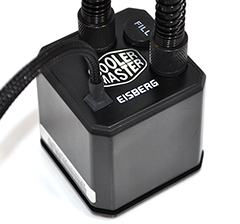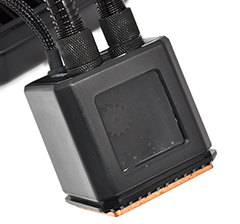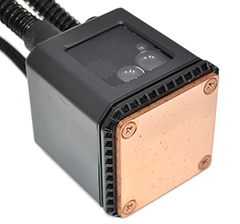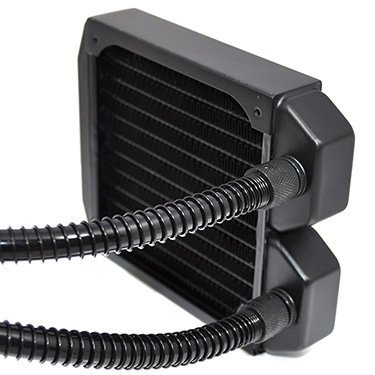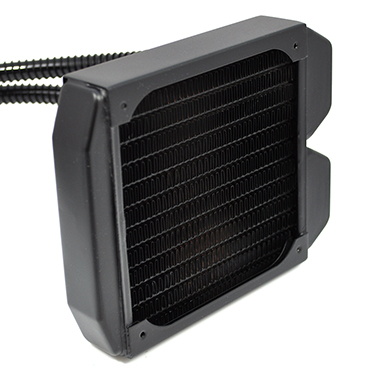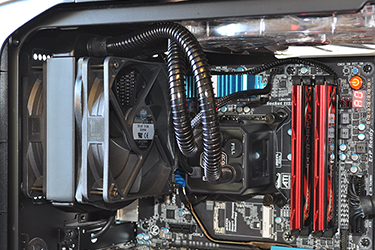A Closer Look
The pump, made by German manufacturer Eheim, is a powerful unit capable of operating at 3,600RPM and sources juice from a single three-pin connector. It feels well-built, but we have reservations about using it at full tilt; it's noticeably loud and we had to use the bundled 9V step-down adaptor to reduce the speed to a less vocal 2,800RPM.
A liquid mixture of water and ethanediol courses through its veins, and the copper base plate is aided by MicroChannel technology and a JetStream plate that's designed to accelerate flow. The presence of air can be detected by looking into the pump's window, and if air happens to be inside the loop, Cooler Master suggests topping up with water; simply remove the fill cap to do so, though preferably not while inside your PC.
Underneath the pump, the copper cold plate is suitably smooth in appearance, but falls short of a completely clean look due to a few small marks.
Flexible black tubing (5/16in inner diameter, 7/16in outer diameter) connects the pump to a 30mm-thick radiator, which, as mentioned previously, is an Alphacool NexXxoS ST30 that alone retails at around £25.
Build quality again is good, but for overclockers and extreme users, it's worth noting that Cooler Master has previously teased an Eisberg with a 120mm radiator that's 45mm thick; we suspect that model will appear in due course dubbed the Eisberg Prestige 120XL.
Both the pump and radiator are solid, but installation on an Intel Socket LGA1155 is tricky at best. Whereas some of Cooler Master's closed-loop competitors have been praised for making liquid cooling easy to install, this is an area in which the Eisberg falls short.
There's no rear mounting bracket, which suggests that installation should be straightforward, but Cooler Master, instead, uses plastic threaded inserts that pop into the motherboard's four mounting holes. Threaded rods then screw into these mounting points, allowing for the pump to be eased on top.
A washer, spring and knurled nut fixes it all together, and though it sounds simple enough, the underlying plastic inserts aren't strong enough; they turn as you're tightening up (their size makes them difficult to clamp still) and they can pop-out too easily. One corner of our review sample popped out of the board twice, and on each occasion we had to disassemble the unit and start over.
The radiator, which should be even easier to install, also proves to be more awkward than anticipated. Cooler Master's small instruction manual suggests that the rubber fan surrounds should be sandwiched between each fan and the radiator, but in doing so, the bundled screws aren't long enough to pass through the rear wall of our Corsair chassis and into the rad.
We had to lose one of the rubber fan surrounds in order to get the radiator attached, but even then things are tricky. Cooler Master has opted to use Allen-head screws, and the heads are so small that they'll pass straight through the fan-mounting holes on most chassis. We had to use third-party rubber mounts to give the screws something to grip onto. On top of all that, there's no Y-cable included in the box, so you'll be using three on-board headers for one cooler (pump, fan, fan).
Installation really should be easier, and the overall aesthetic appearance won't be to everyone's taste. The radiator, sandwiched between two 120mm fans, looks big and bulky.
Performance benchmarks are coming up, but before we get to that, we'll rate the Eisberg Prestige 120L on presentation, installation and aesthetics. In keeping with our recent CPU cooler reviews, each category is scored out of five and we provide an overall percentage, too.
Presentation |
Installation |
Aesthetics |
 |
 |
 |
 |
Cooler Master isn't off to a great start - the Eisberg Prestige 120L proved to be too awkward to install for our liking and it isn't particularly attractive in terms of in-chassis appearance - but that won't matter too much if performance is up to snuff. Let's get on to the benchmarks.






